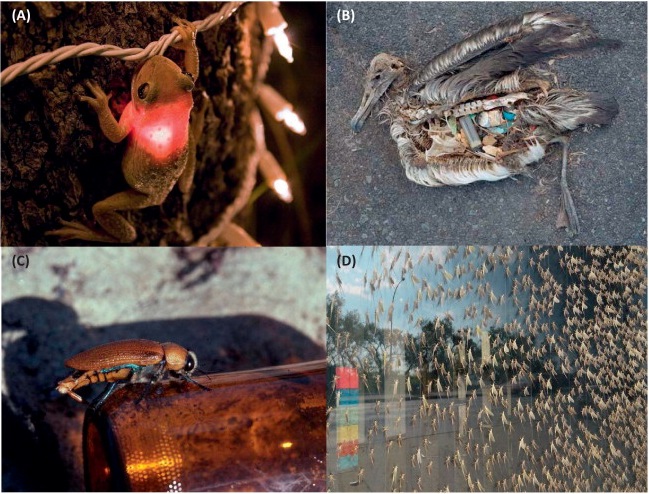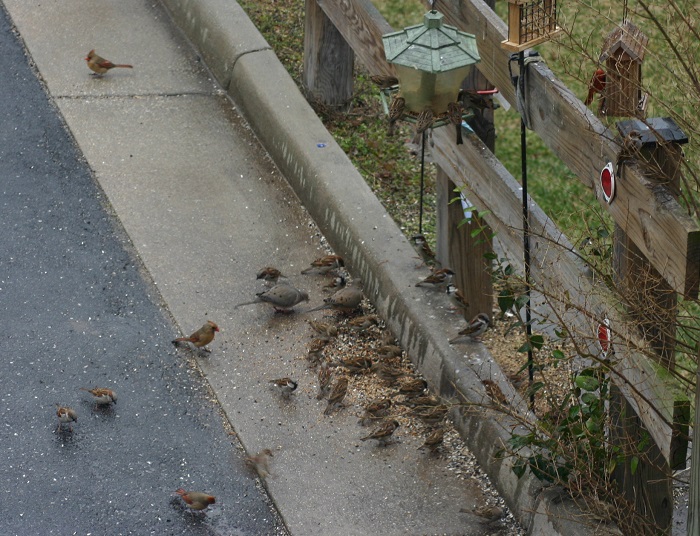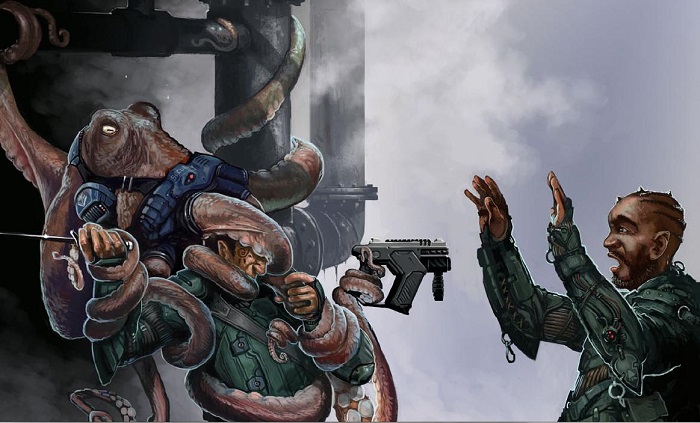
“Examples of animals exhibiting maladaptive responses to evolutionary novel objects and becoming trapped. (A) A Cuban tree frog (Osteopilus septentrionalis) ingesting a decorative light that mimics the bioluminescent qualities of its insect prey. (B) A black-footed albatross (Phoebastria nigripes) killed by the ingestion of small, often colorful, floating garbage that mimics food items. (C) A giant jewel beetle (Julodimorpha bakewelli) attempting to mate with a beer bottle that produces supernormal strengths of coloration and reflection cues associated with female conspecifics [74]. (D) Mayflies blanketing, mating, and ovipositing on a storefront window that strongly reflects horizontally polarized light, their primary habitat selection cue in locating natural water bodies.”
Credit: (Source) Images by James Snyder (A), Chris Jordan (B), Darryl Gwynne (C), and Will Milne (D) (Copyrighted, reproduced here as fair use).
Carl Zimmer has an article summarizing the research presented by Robertson, Rehage, and Sih concerning evolutionary traps, when “rapid environmental change triggers organisms to make maladaptive behavioral decisions.” In other words, we change the environment in ways that cause animals to exhibit behaviors harmful to themselves.
Zimmer gives the example of the albatross, which “will peck at brightly colored pieces of plastic floating in the water, for example. It’s a response that used to give them energy but now can fill their guts with trash.” Witherington gives the example of sea turtles, which “have evolved the tendency to migrate toward the light of the moon upon emerging from their sand nests. However, in the modern world, this has resulted in them tending to orient towards bright beach-front lighting, which is a more intense light source than the moon. As a result the hatchlings migrate up the beach and away from the ocean where they exhaust themselves, desiccate and die either as a result of exhaustion, dehydration or predation.” Sea turtles also mistake plastic bags for jellyfish and consume them. In 2011 Darryl Gwynne and David Rentz won an IgNobel for their research on the giant jewel beetle, which attempts to mate with a certain brand of beer bottle because they exhibit “supernormal strengths of coloration and reflection cues associated with female conspecifics.”

Cardinal at Our Feeder
Before you laugh at the silly beetle, remember that men and women all over the world are “mating” with their computers via pornography, which is really just pixels arranged to provoke human sexual desire. There’s also the influx of cheap calories into our environment, promoting the epidemic of obesity in America. Let’s also be mindful of the influx of social information through sites like Facebook, which triggers our need for social “gossip” and similar data that was important for when we began gathering into tribes. Humans are falling into evolutionary traps of our own designs.
Even some of our good intentions toward animals are forms of evolutionary traps. I grew up on a small pond in Virginia Beach with a large population of ducks. These ducks were heavily fed by everyone on the lake, and they would all congregate around the docks whenever people were out to beg for scraps of bread. You could even feed them by hand, and my brother was able to catch one briefly because they had grown so trusting. The problem with all this inter-species friendliness was that the ducks wouldn’t properly prepare for winter because of the great food resource we provided and would end up dying after failing to properly fatten up. As a neighborhood, we spread the word around the pond and got everyone to stop feeding the ducks, which quickly got them to move on to more natural environments. Today, instead of dozens of ducks, you rarely see more than six in the pond at one time. As it should be.

Our Yard Feeder
My mother-in-law maintains several bird feeders, which make for a very pleasant viewing. Birds of a variety of species flock together momentarily to get the seeds, but quickly disperse when I come near. Recently, my sister-in-law Carolyn got her a bird feeder that sticks to a window, which she adhered to the sliding-glass door in our living room. The birds who feed there are easily scared away when they see us, but the cardinals and sparrows keep coming back to feed despite our proximity. Being familiar with the self-domestication hypothesis of wolves into dogs, I began to wonder if the same could happen with the birds given a few centuries or millennia.
With dogs, the hypothesis goes, ancient wolves would scavenge from human campsites. Wolves that had shorter escape distances–those who could get closer to humans, would get more food. Thus, human changes to the environment, leaving leftovers out for the wolves, began to select for wolves with shorter and shorter escape distances. Eventually, wolves became domesticated, cohabiting with humans. Interestingly enough, soviet scientist Dmitri Belyaev spent 50 years domesticating the red fox into the silver fox. As the foxes became tamer, they also became more dog-like, “eager to establish human contact, whimpering to attract attention and sniffing and licking experimenters like dogs.”
So if the hypothesis holds, then a similar experiment is being conducted with backyard birdfeeders all over the country right now. Birds with shorter escape distances will monopolize the near-endless resource of the feeder and increase their fitness. Over time, it’s perceivable that these birds might self-domesticate like our dogs may have done.

House Sparrows at the Feeder
The Audubon Society appears to encourage bird feeders, which make for great bird-watching, but there are negative impacts of bird feeders as well. One of these is the fact that feeders favor House Sparrows, a species which appears to have a long relationship with humans and is considered a pest for eating crops, spreading disease, molesting other birds, and nesting in nooks and crannies of our homes. It seems as though the House Sparrow is the jerk of the bird world. So it should be no surprise that at least 90% of the bird-sightings I make at our window-feeder are House Sparrows. Our window-feeder is selecting for House Sparrows.
In science fiction, we have the concept of uplift, where scientists and civilizations intentionally direct the evolution of certain species–most often to increase their intelligence. This was the plot of H.G. Wells Island of Doctor Moreau, the focus of David Brin’s Uplift Series, and a key element of Posthuman Studio’s Eclipse Phase universe. Some of these stories are cautionary, while others are inspiring. I mention them because they are examples of human beings being cognizant of how they are influencing the evolution of the myriad species with whom we share this planet. Domesticating dogs, cats, cattle, pigs, sheep, chickens, horses, pigeons, ferrets, etc, etc is a large part of how humans change the environment.
Robertson, Rehage, and Sih argue that we need to be more mindful of how our rapid changes to the environment are triggering maladaptations in the species who live here:
Human-induced rapid environmental change (HIREC; e.g., climate change or exotic species) has caused global species declines. Although behavioral plasticity has buffered some species against HIREC, maladaptive behavioral scenarios called ‘evolutionary traps’ are increasingly common, threatening the persistence of affected species. Here, we review examples of evolutionary traps to identify their anthropogenic causes, behavioral mechanisms, and evolutionary bases, and to better forecast forms of HIREC liable to trigger traps. We summarize a conceptual framework for explaining the susceptibility of animals to traps that integrates the cost–benefit approach of standard behavioral ecology with an evolutionary approach (reaction norms) to understanding cue–response systems (signal detection). Finally, we suggest that a significant revision of conceptual thinking in wildlife conservation and management is needed to effectively eliminate and mitigate evolutionary traps.
I have extended the need for this mindfulness to the human animal, with pornography, diets, and social networking. Being aware of how these changes can affect us will improve our well-being. Even something as simple and enjoyable as a bird feeder has consequences for which we should be mindful. By monitoring how life interacts with the new environments we introduce, we can monitor the health of other species and our own.


Comments
3 responses to “Bird Feeders, Pornography, and Other Evolutionary Traps”